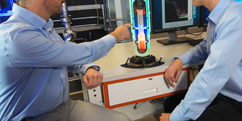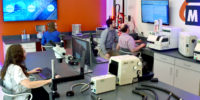
[scf-post-title]
AMS is performing research for the U.S. Department of Energy on I&C issues in small modular reactors (SMRs) and advanced reactors. Important to the safe and efficient operation of any nuclear power plant is the measurement of process conditions: temperature, pressure, level, flow, and neutron flux. There are many aspects associated with the I&C design of a reactor. However, AMS is primarily concerned with the sensor-to-process interface and how to measure the process effectively. This begins with understanding the complexity of the system and evaluating the feasibility of utilizing existing sensing technologies coupled with novel testing techniques for use in SMRs or advanced reactors.
SMRs are considered to be nuclear power reactors that output less than 300 MWe (large conventional plants are typically ~1000 MWe) and can be factory-fabricated and transportable to the plant site via truck, rail, or barge.
SMRs are considered to be nuclear power reactors that output less than 300 MWe (large conventional plants are typically ~1000 MWe) and can be factory-fabricated and transportable to the plant site via truck, rail, or barge.
SMRs are attractive for deployment in remote locations (e.g. mining sites, island communities, military installations, etc.) and cost less to build and operate. Some SMR designs can accommodate extended refueling cycles (> 18 months) and incorporate passive safety features like natural circulation cooling (no reactor coolant pumps necessary for plant safety). The most innovative and distinctive feature of some SMRs is the “integral” reactor design, which means the SMR has no reactor coolant piping (i.e. the steam generators are located inside the reactor pressure vessel).
SMR technology is generating great interest worldwide. The International Atomic Energy Agency (IAEA) has witnessed an increase in participation from member states in its program to accelerate the technology development of SMRs and ultimately move toward design certification. The need for flexible power generation deployable in less-developed countries, replacement of aging fossil fuel plants, enhancement of safety features, improved upfront capital cost, and the capability for cogeneration are all key driving forces behind this global push for SMRs..
SMR technology is generating great interest worldwide. The International Atomic Energy Agency (IAEA) has witnessed an increase in participation from member states in its program to accelerate the technology development of SMRs and ultimately move toward design certification. The need for flexible power generation deployable in less-developed countries, replacement of aging fossil fuel plants, enhancement of safety features, improved upfront capital cost, and the capability for cogeneration are all key driving forces behind this global push for SMRs..






























